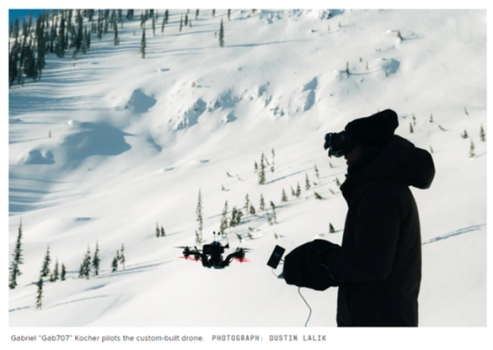K
Kathleen Martin
Guest
FILMING A TOP-LEVEL backcountry snowboarding event presents distinct technical challenges. The action moves all over the mountain; riders navigate through groups of trees, sail over jumps, and carve around obstacles, all the while making split-second adjustments to their speed and direction. The unpredictable and fast-paced nature of the competition can leave even the most talented camera operators struggling to keep up.
For Travis Rice and Liam Griffin, the organizers of the Natural Selection Tour, this issue was compounded by the fact that they wanted to broadcast their event live. The annual three-stop jamboree sees a hand-picked field of the world’s top snowboarders (eight women and 16 men) compete at specially selected courses in Jackson Hole, Wyoming; Alaska; and British Columbia.
So when it came to finding a broadcast solution for the snowboarding event, the team decided to ditch the traditional methods for shooting backcountry action and instead focus on a completely new approach: a modified racing drone specially outfitted with cameras and transmitters to capture live images of some the world’s best athletes. (Disclosure: The author has served on the selection committee that picks the riders who get invited.)
Natural Selection COO Liam Griffin explains that snowboarding footage is traditionally captured by a camera using a long-angle lens set up on an opposing mountain range, or from helicopters. “But this means the cameras—and hence the viewers—are fundamentally far away from the action,” he says.
Instead, Rice and Griffin wanted to place the camera as close as possible to the action, enabling the viewer to “be there” alongside each rider as they take their runs.
“We wanted to make the event more immersive and easier to understand for anybody watching,” Griffin says. “For most people, even seasoned snowboarders, it can be really difficult to comprehend.”
Filming the action with either a racing drone or a camera drone was one obvious solution. But as Travis Rice, himself one of the world’s most decorated professional snowboarders, explains, “the drone technology didn’t yet exist” to follow a competitor down the whole course at close range in the way the pair envisioned.
Continue reading: https://www.wired.com/story/natural-selection-snowboarding-custom-drone/
For Travis Rice and Liam Griffin, the organizers of the Natural Selection Tour, this issue was compounded by the fact that they wanted to broadcast their event live. The annual three-stop jamboree sees a hand-picked field of the world’s top snowboarders (eight women and 16 men) compete at specially selected courses in Jackson Hole, Wyoming; Alaska; and British Columbia.
So when it came to finding a broadcast solution for the snowboarding event, the team decided to ditch the traditional methods for shooting backcountry action and instead focus on a completely new approach: a modified racing drone specially outfitted with cameras and transmitters to capture live images of some the world’s best athletes. (Disclosure: The author has served on the selection committee that picks the riders who get invited.)
Natural Selection COO Liam Griffin explains that snowboarding footage is traditionally captured by a camera using a long-angle lens set up on an opposing mountain range, or from helicopters. “But this means the cameras—and hence the viewers—are fundamentally far away from the action,” he says.
Instead, Rice and Griffin wanted to place the camera as close as possible to the action, enabling the viewer to “be there” alongside each rider as they take their runs.
“We wanted to make the event more immersive and easier to understand for anybody watching,” Griffin says. “For most people, even seasoned snowboarders, it can be really difficult to comprehend.”
Filming the action with either a racing drone or a camera drone was one obvious solution. But as Travis Rice, himself one of the world’s most decorated professional snowboarders, explains, “the drone technology didn’t yet exist” to follow a competitor down the whole course at close range in the way the pair envisioned.
Continue reading: https://www.wired.com/story/natural-selection-snowboarding-custom-drone/

